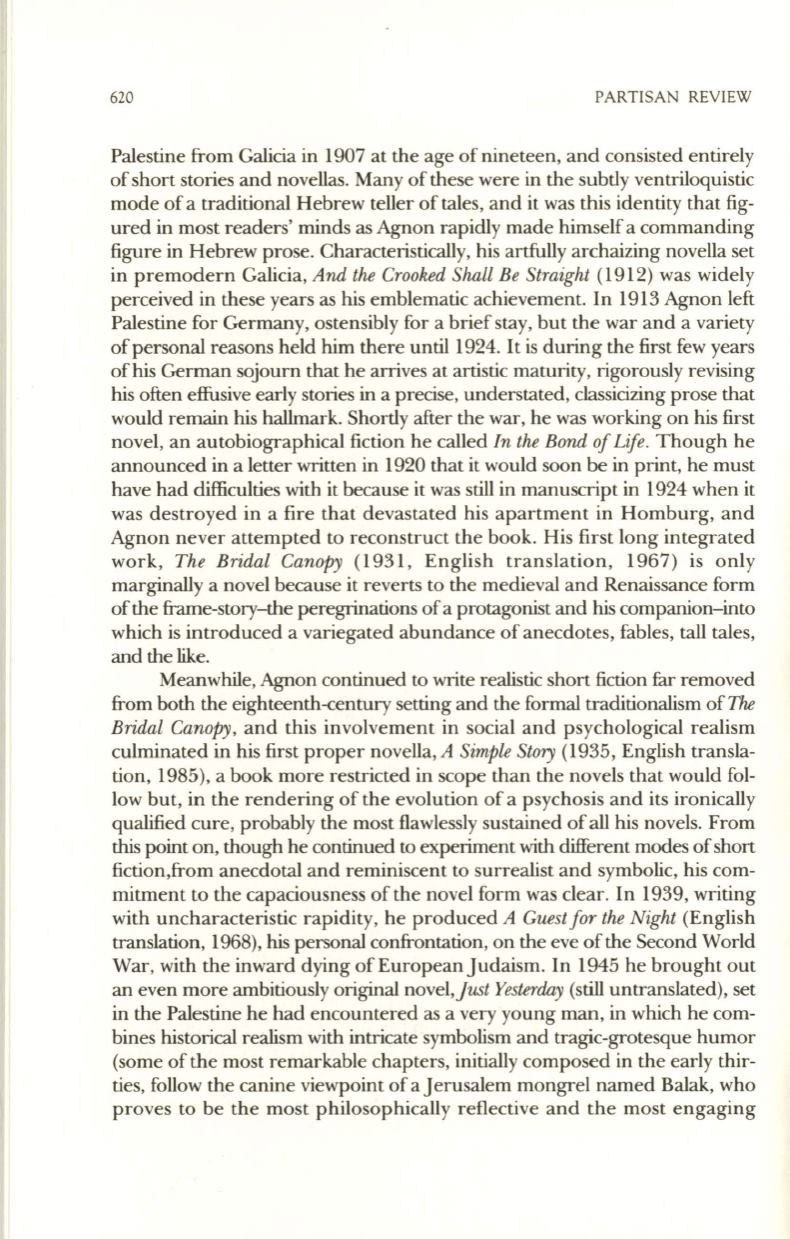
620
PARTISAN REVIEW
Palestine from Galicia in 1907 at the age of nineteen, and consisted entirely
of short stories and novellas. Many of these were in the subtly ventriloquistic
mode of a traditional Hebrew teller of tales, and it was this identity that fig–
ured in most readers' minds as Agnon rapidly made himself a commanding
figure in Hebrew prose. Characteristically, his artfully archaizing novella set
in premodern Galicia,
And the Crooked Shall Be Straight
(1912) was widely
perceived in these years as his emblematic achievement. In 1913 Agnon left
Palestine for Germany, ostensibly for a brief stay, but the war and a variety
of personal reasons held him there until 1924. It is during the first few years
of his German sojourn that he arrives at artistic maturity, rigorously revising
his often effusive early stories in a precise, understated, classicizing prose that
would remain his hallmark. Shortly after the war, he was working on his first
novel, an autobiographical fiction he called
In the Bond of Life.
Though he
announced in a letter written in 1920 that it would soon be in print, he must
have had difficulties with it because it was still in manuscript in 1924 when it
was destroyed in a fire that devastated his apartment in Homburg, and
Agnon never attempted to reconstruct the book. His first long integrated
work,
The Bridal Canopy
(1931, English translation, 1967) is only
marginally a novel because it reverts to the medieval and Renaissance form
of the frame-story-the peregrinations ofa protagonist and his companion-into
which is introduced a variegated abundance of anecdotes, fables, tall tales,
and the like.
Meanwhile, Agnon continued to write realistic short fiction far removed
from both the eighteenth-century setting and the formal traditionalism of
The
Bridal Canopy,
and this involvement in social and psychological realism
culminated in his first proper novella,
A Simple Story
(1935, English transla–
tion, 1985), a book more restricted in scope than the novels that would fol–
low but, in the rendering of the evolution of a psychosis and its ironically
qualified cure, probably the most flawlessly sustained of all his novels. From
this point on, though he continued to experiment with different modes ofshort
fiction,from anecdotal and reminiscent to surrealist and symbolic, his com–
mitment to the capaciousness of the novel form was clear. In 1939, writing
with uncharacteristic rapidity, he produced
A Guest for the Night
(English
translation, 1968), his personal confrontation, on the eve of the Second World
War, with the inward dying of European Judaism. In 1945 he brought out
an even more ambitiously original
novel,just Yesterday
(still untranslated), set
in the Palestine he had encountered as a very young man, in which he com–
bines historical realism with intricate symbolism and tragic-grotesque humor
(some of the most remarkable chapters, initially composed in the early thir–
ties, follow the canine viewpoint ofaJerusalem mongrel named Balak, who
proves to be the most philosophically reflective and the most engaging


